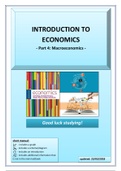Summary
Summary EC1002 Introduction to Economics - Part 4: Macroeconomics
- Course
- Institution
- Book
Part 4 of detailed summary of EC1002 - Introduction to Economics, based on the textbook 'Economics' by Begg, Fischer, Vernasca and Dornbusch (11th edition). Beginner level, for introductory economics course. Part 4 includes chapters 15-25 and 28, namely: GDP and aggregate demand - IS-LM model - AS-...
[Show more]



